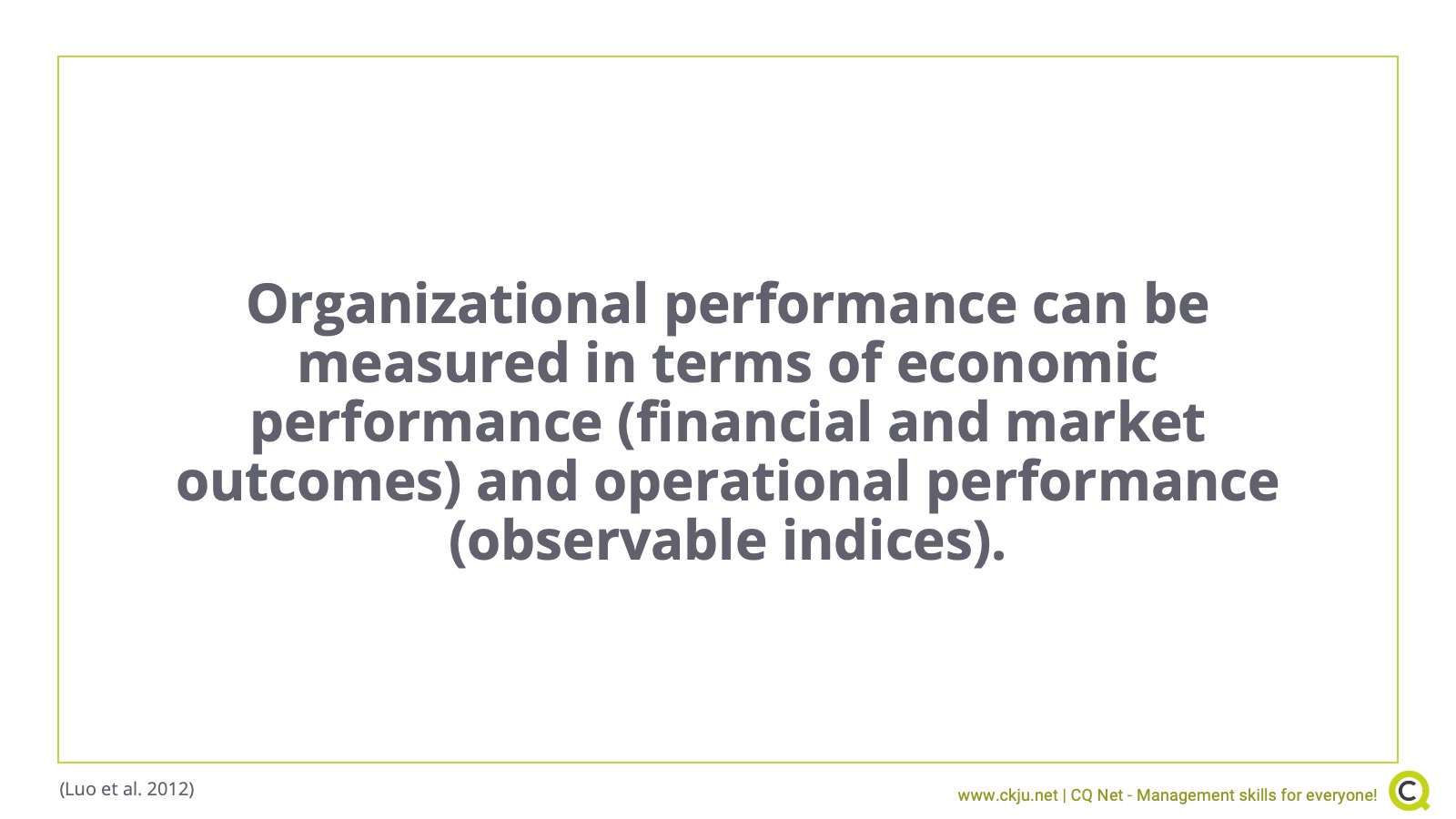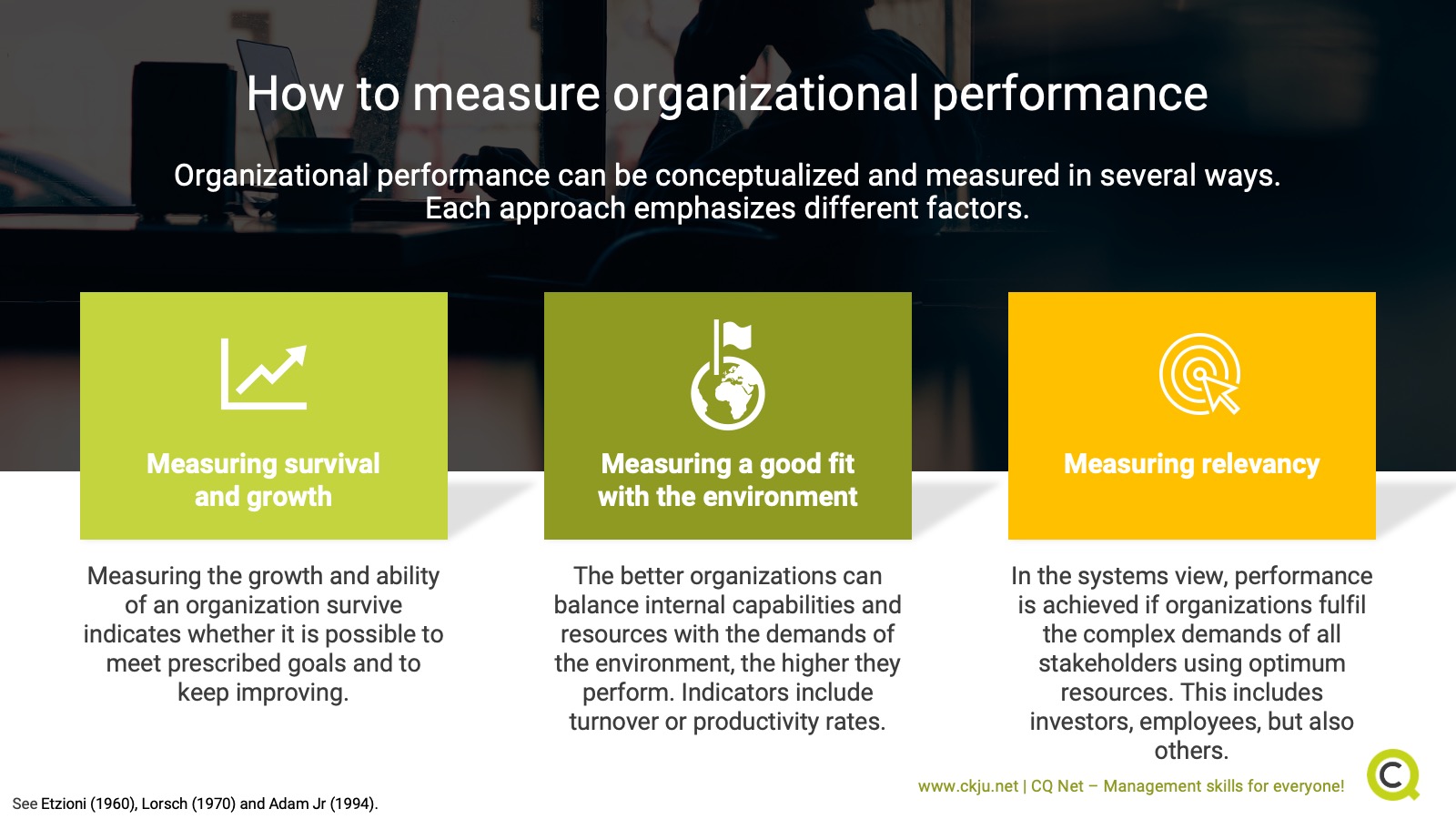- All Management Learning Resources
- Organizational performance

Why you should care about organizational performance?
Organizational performance is a ubiquitous term which is nevertheless loosely defined. Though the construct depends on a number of unique factors associated with each organization, yet the lack of a universal definition makes it challenging for professionals to concur about what exactly they mean by organizational performance. This CQ Dossier summarizes the existing evidence about the financial, social, psychological, and operational aspects of organizational performance to arrive at a comprehensive definition and introduce interventions how to improve it.
Contents
- Why you should care about organizational performance?
- What is organizational performance?
- Definition of organizational performance is elusive
- How does organizational performance work?
- How to measure organizational performance?
- How to measure organizational performance at different levels?
- Organizational performance is a powerful concept and management tool
- Critical appraisal of Organizational Performance: Solidity Rating 4
- Key recommendations for professionals
- References and further reading
What is organizational performance?
There are possibly as many interpretations of the term organizational performance as the studies that have used the construct. Luo et al. (2012) who conducted a meta-analysis of organizational performance suggested that it should be measured in economic and operational terms:
- The economic performance looks at financial and market outcomes which assess the profits, sales, return on investment for shareholders, and other financial metrices.
- The operational performance, on the other hand, focuses on the observable indices like customer satisfaction and loyalty, the firm’s social capital, and competitive edge derived from capabilities and resources.
Definition of organizational performance is elusive
Organizational performance is measured for different levels of hierarchy and can be assessed for individuals, groups, and the entire organization as a whole (Knies, Jacobsen and Tummers, 2016).
A systematic literature review of 213 studies published in reputed journals or a period of only three years (2006-09) revealed 207 different measures used for assessing performance (Richard et al., 2009).
Eventually, the researchers settled on a multi-dimensional construct of organizational performance with financial performance, product market performance, and shareholder return forming three crucial aspects.
How does organizational performance work?
To answer this question is to define organizational performance. Kanter and Brinkerhoff (1981) have pointed out that the measures for organizational performance depend on who is asking the questions and why they need to measure performance. Some of the reasons why professionals need to measure and report organizational performance are to justify the valid use of investors’ money, guide managerial decision making by pointing out the trouble areas, compare performances of different functions, projects, and people, and to exercise control. Therefore, the definition of organizational performance can change as per the use it is put to.
How to measure organizational performance?
There are various way how organizational performance can be measured. We have a look at some of the most prominent and effective ones.
As a measure of survival and growth
One of the clearest definitions of Organizational performance describes it in terms of growth and survival of the firm (Etzioni, 1960; Chandler and Hanks, 1993).In this definition, a firm may consider its performance to be effective if it is able to meet its prescribed goals and continue to improve. The weakness in this approach is that it fails to account for the external and internal environment of the firm.
As a measure of good fit with environment
This limitation has been provided for by Lorsch (1970) who believed that firms who are able to find the right fit between their environmental demands and internal capabilities and resources are able to perform better. A similar position was adopted by Lupton, Gribbin and Warmington (1977) who defined good organizational performances to be those which were able to achieve high productivity and employee satisfaction with low turnover rates and costs.
As a measure of relevancy
Though this definition addresses the systems view of organizations, it still fails to consider the volatility of modern markets and how they pressurize firms to evolve continuously. This critical aspect, termed relevancy by Jenatabadi (2015), is found in studies from the twenty-first century. Modern organizations are no longer required to only fulfill the demands of their investors and employees, but an entire gamut of stakeholders (Adam Jr, 1994; Harrison and Freeman, 1999).
This development has created one of the most comprehensive definitions of organizational performance which combines the constructs of efficiency, effectiveness, and relevancy. Successful organizational performance is thus, where objectives are met with optimum resources to fulfill relevant stakeholder demands.
How to measure organizational performance at different levels?
We measure organizational performance so we can improve it. Regardless of the aim of measuring organizational performance or the definition of the adopted terms, professionals are always looking at ways to build upon past performance. Considering the different levels of performance assessment, a number of interventions are recognized to be useful.
Individual level performance
At the individual level, task performance, contextual performance, adaptive performance, and counterproductive work behavior are the main dimensions identified in an exhaustive search of medical, psychological and management studies (Koopmans et al., 2011).
- Task performance is broadly indicated by the successful completion of assigned tasks, the number and quality of work, skills and knowledge of the performer, and the managerial abilities of planning, organizing, problem-solving, monitoring, and decision-making.
- Contextual performance encompasses all such actions which extend beyond the prescribed task roles and can manifest in social, organizational or psychological realms. This performance is associated with indicators like initiative, extra tasks performed, resourcefulness, enthusiasm, motivation, creativity, commitment and interpersonal relationships.
- Adaptive performance denotes the responsiveness at work and is measured through innovation, adjustment to changing circumstances, flexibility and open-mindedness, and continuous learning.
- Finally, the counterproductive work behaviors are indicated by the absenteeism, theft, tardiness, disregard of instructions, safety regulations, substance abuse, and any other off-task behaviors that undermine performance.
Team level performance
For teams level organizational performance too completion of a task is an important measure (DeChurch and Mesmer-Magnus, 2010). Moreover, task proficiency is another indicator of good performance as team members who are proficient in their tasks are associated with higher performance levels.
Kendall and Salas (2004) have reported several models of assessing team performance ranging from Input-process-output which takes a systems view of team processes to looking at team tasks as events where performance measurement aids like the behaviorally anchored rating and Observation scale (BARS) and self-report measures are employed. These measures should assess the team adaptability, team orientation, leadership, and back up behaviors to measure team performance.
Organizational level performance
When assessing the organization’s performance as a whole, a cohort of measures need to be adopted so that all components can be monitored and evaluated comprehensively. In fact, there is a conscious call to move towards a broader definition of organizational performance, one which recognizes and addresses sustainability of work processes and outcomes (Hubbard, 2009).
Another key variable in measuring organizational performance is integrating a formal assessment of strategic planning in its measurement (George, Walker and Monster, 2019). When organizations assess their strategic planning using internal and external assessments with a cascading system of goals, strategies, and plans, the effectiveness of meeting these goals is found to be improved.
Richard et al. (2009) have added that professional need to establish a strong rationale for understanding what is meant by performance and the choice of measures that will be employed to measure it. While defining what is meant by performance, managers should reflect on all stakeholders, the degree of heterogeneity in the environment, resources, and strategic choices, and the time frame.
How to compare organizational performance across-organizations
When measuring performance across organizations belonging to a similar context, it is the human capital that acts as one of the distinguishing factors. The resource-based theory (RBT) is used by many researchers to identify human capital as being a significant indicator of organizational performance, especially, in deriving a competitive advantage over others (Crook et al., 2008, 2011).
Another key variable that is heterogenous and is, thus, useful for measuring organizational performance across firms is market orientation (MO). MO includes (Shoham et al., 2006)
- the ability to collect market information,
- disseminate within the organization, and
- respond to it through effective decision-making.
Therefore, it is possible to assess where a firm stands with respect to its customers, competitors, and within its different functions using MO.
Organizational performance is a powerful concept and management tool
Organizational performance may be a loosely defined construct but understanding the broad ways it has been defined in terms of components – financial, market, shareholder return, and sustainability shows how a professional can choose the right mix of indicators for assessing it. There are several indicators employed to measure organizational performance at different levels. Ultimately, it is the purpose for which performance needs to be measured that determines the right definition.
Critical appraisal of Organizational Performance: Solidity Rating 4
Organizational performance has been reviewed in hundreds of studies with many meta-analytical researches dedicated to defining, measuring, and relating this construct to individual, group, and organizational parameters of success. Still, despite being a multi-dimensional construct, experimental research and designs that allow confounding variables are in short supply. As a result, we assign the evidence supporting the concept of organizational performance a solidity rating of 4 on a 1-5 measurement scale.
Key recommendations for professionals
- When defining organizational performance, begin by finalizing the purpose for which you need it.
- Once the purpose is identified, choose the levels at which performance will need to be assessed – individual, team, organizational, across organizations, or a combination.
- Once the levels of measurement are identified, the actual indicators can be chosen to arrive at your very own custom-made organizational performance.
References and further reading
Adam Jr, E. E. (1994) ‘Alternative quality improvement practices and organization performance’, Journal of Operations Management, 12(1), pp. 27–44.
Chandler, G. N. and Hanks, S. H. (1993) ‘Measuring the performance of emerging businesses: A validation study’, Journal of Business Venturing, 8(5), pp. 391–408. doi: 10.1016/0883-9026(93)90021-V.
Crook, T. R. et al. (2008) ‘Strategic resources and performance: a meta‐analysis’, Strategic management journal, 29(11), pp. 1141–1154.
Crook, T. R. et al. (2011) ‘Does human capital matter? A meta-analysis of the relationship between human capital and firm performance.’, Journal of Applied Psychology, 96(3), pp. 443–456. doi: 10.1037/a0022147.
DeChurch, L. A. and Mesmer-Magnus, J. R. (2010) ‘The cognitive underpinnings of effective teamwork: a meta-analysis.’, Journal of applied psychology, 95(1), p. 32.
Etzioni, A. (1960) ‘Two approaches to organizational analysis: A critique and a suggestion’, Administrative science quarterly, pp. 257–278.
George, B., Walker, R. M. and Monster, J. (2019) ‘Does Strategic Planning Improve Organizational Performance? A Meta‐Analysis’, Public Administration Review, 79(6), pp. 810–819. doi: 10.1111/puar.13104.
Harrison, J. S. and Freeman, R. E. (1999) ‘Stakeholders, social responsibility, and performance: Empirical evidence and theoretical perspectives’, Academy of management Journal, 42(5), pp. 479–485.
Hubbard, G. (2009) ‘Measuring organizational performance: beyond the triple bottom line’, Business Strategy and the Environment, 18(3), pp. 177–191. doi: 10.1002/bse.564.
Jenatabadi, H. S. (2015) ‘An overview of organizational performance index: Definitions and measurements’, Available at SSRN 2599439.
Kanter, R. M. and Brinkerhoff, D. (1981) ‘Organizational performance: Recent developments in measurement’, Annual review of sociology, 7(1), pp. 321–349.
Kendall, D. L. and Salas, E. (2004) ‘Measuring team performance: Review of current methods and consideration of future needs’, in The science and simulation of human performance. Emerald Group Publishing Limited.
Knies, E., Jacobsen, C. and Tummers, L. (2016) ‘Leadership and organizational performance’, J. Storey, J. Hartley, J.-L. Denis, P.‘t Hart, & D. Ulrich, pp. 404–418.
Koopmans, L. et al. (2011) ‘Conceptual frameworks of individual work performance: a systematic review’, Journal of occupational and environmental medicine, 53(8), pp. 856–866.
Lorsch, J. W. (1970) ‘Introduction to the structural design of organizations’, Organizational structure and design, 1, p. 16.
Luo, Y., Huang, Y. and Wang, S. L. (2012) ‘Guanxi and organizational performance: A meta-analysis’, Management and Organization Review, 8(1), pp. 139–172.
Lupton, T., Gribbin, C. and Warmington, W. (1977) ‘Organizational Behavior and Performance’.
Richard, P. J. et al. (2009) ‘Measuring Organizational Performance: Towards Methodological Best Practice’, Journal of Management, 35(3), pp. 718–804. doi: 10.1177/0149206308330560.
Shoham, A. et al. (2006) ‘Market Orientations in the Nonprofit and Voluntary Sector: A Meta-Analysis of Their Relationships With Organizational Performance’, Nonprofit and Voluntary Sector Quarterly, 35(3), pp. 453–476. doi: 10.1177/0899764006287671.
About the Author





